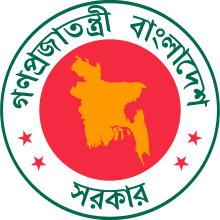Provisional Government of Bangladesh
| Provisional Government of the People's Republic of Bangladesh | ||||||||||
| গণপ্রজাতন্ত্রী বাংলাদেশ অস্থায়ী সরকার Gônôprôjatôntri Bangladesh Ôsthayi Sôrkar | ||||||||||
| Provisional government | ||||||||||
| ||||||||||
.svg.png) | ||||||||||
| Capital | Mujibnagar | |||||||||
| Capital-in-exile | Calcutta | |||||||||
| Languages | Bengali | |||||||||
| Government | Transitional Republic | |||||||||
| Prime Minister | ||||||||||
| • | 1971–1972 | Tajuddin Ahmad | ||||||||
| Historical era | Bangladesh Liberation War | |||||||||
| • | Established | 17 April 1971 | ||||||||
| • | Disestablished | 12 January 1972 | ||||||||
| ||||||||||
The Provisional Government of the People's Republic of Bangladesh was established following the declaration of independence of East Pakistan on 10 April 1971. It was the supreme leadership of the Bangladeshi liberation movement. It included the first cabinet of Bangladesh; the nascent Bangladeshi diplomatic corps; the Constituent Assembly of Bangladesh; the Mukti Bahini military, paramilitary and guerrilla forces; and the Independent Bangladesh Radio .
The provisional government was formed in the town of Mujibnagar (formerly Baidyanathtala). Its capital in exile was Calcutta, the capital of the Indian state of West Bengal and the former capital of British India, which hosted thousands of Bangladeshi refugees escaping the 1971 genocide. The provisional government included many defectors from the Pakistani government, foreign service and military; as well as leading intellectuals and cultural figures from East Pakistan. Its chief executive was Tajuddin Ahmad, the first Bangladeshi Prime Minister.
Acting as a wartime administration, the Provisional Government's principal responsibility was coordinating war efforts. With support from India, its military forces waged a successful guerrilla war against Pakistan, securing control of Bangladesh's countryside.[1] A worldwide campaign was undertaken by the Provisional Government to garner support for Bangladesh's independence, genocide victims and refugees. It appointed special envoys and operated representative missions in New Delhi, Washington D.C. and London among many other cities.
Formation
The provisional government was established in the town on Baidyanathtala in Meherpur, Kushtia District. Its leaders were administered their oaths at a mango orchard near the site of the Battle of Plassey, in which the British defeated the last independent Nawab of Bengal in 1757.[2]
.jpg)
Constitution
The legal basis of the Bangladeshi provisional government was provided by the proclamation of independence issued on 10 April 1971, which served as the interim constitution of Bangladesh until 1972. It declared that Pakistan failed to convene its elected representatives for framing a new constitution on 3 March 1971; and instead launched an "unjust and treacherous war", a reference to the 1971 Bangladesh genocide.[3] As a result, Sheikh Mujibur Rahman, described as the undisputed leader of the 75 million people of East Pakistan, fulfilled aspirations for self-determination by declaring Bangladesh's independence on 26 March 1971.
The proclamation declared Bangladesh as a People's Republic with equality, human dignity and social justice as its fundamental principles.[4]
Cabinet
| Office holder | Name(s) | Notes |
|---|---|---|
| President | Sheikh Mujibur Rahman | Nominal president. Detained in West Pakistan throughout the war. |
| Vice President | Syed Nazrul Islam | Acting President |
| Prime Minister | Tajuddin Ahmad | Principal wartime political leader. |
| Defence Minister | Colonel M. A. G. Osmani | Commander-in-Chief of the Mukti Bahini |
| Finance Minister | Mansur Ali | |
| Home Minister | Abul Hasnat Muhammad Qamaruzzaman | |
| Foreign Minister | Khondaker Mostaq Ahmad Abdus Samad Azad | Ahmad was removed after attempting secret talks with Islamabad |
Parliament
The interim constitution converted elected Bengali members of Pakistan's national and provincial assemblies into members of the Constituent Assembly of Bangladesh.
Armed forces
The military wing of the provisional government was the Mukti Bahini. The Bangladeshi liberation guerrillas were based in camps on the East Pakistan-India border. In the first months of the war, the Mukti Bahini liberated many districts of Bangladesh; before succumbing to Pakistani onslaughts in the monsoon. The Mukti Bahini secured control of the countryside by November.[1] In December, it joined Indian forces as part of a combined Bangladesh-Indian allied offensive against Pakistan, which resulted in victory.
Bureaucracy
Many Bengali members of the Civil Service of Pakistan defected to the government of Bangladesh. Dr. Kamal Uddin Siddiqui, Nurul Kader Khan, S. A. Samad, Khondker Asaduzzaman, Dr. Sa'dat Hussain and Dr. Akbar Ali Khan were early leaders of the newly formed Bangladesh Civil Service. The provisional government established an elaborate structure of administrative departments. Yusuf Ali and J. G. Bhowmik served as the chief Relief Commissioners for Bangladeshi refugees. The noted artist Quamrul Hassan served as Director of Art and Design. Calcutta and Agartala were the main centers of the government-in-exile.
Key diplomats
| Name | Title | Mission |
|---|---|---|
| Humayun Rashid Choudhury | Ambassador-at-Large | New Delhi |
| Abul Maal Abdul Muhith | Ambassador-at-Large | Washington D.C. |
| Rehman Sobhan | Special Envoy | Washington D.C. |
| Justice Abu Sayeed Chowdhury | Chief Overseas Representative[5] | London |
| Abul Fateh | Ambassador-at-Large | Calcutta |
Cultural wing
The Swadhin Bangla Betar Kendra served as the cultural propaganda wing of the Bangladeshi provisional government.
See also
References
- 1 2 Bass, Gary (2014). The Blood Telegram: Nixon, Kissinger, and a Forgotten Genocide J. Knopf Doubleday Publishing Group. ISBN 978-0-307-74462-3.
- ↑ "Genesis of Bangladesh's Constitution". The Daily Star. Retrieved 2016-04-19.
- ↑ http://www.docstrangelove.com/uploads/1971/sbbk/documents/Proclamation%201971_M_Dalil_Vol_03_MMR.pdf
- ↑ http://www.docstrangelove.com/uploads/1971/sbbk/documents/Proclamation%201971_M_Dalil_Vol_03_MMR.pdf
- ↑ http://www.mofa.gov.bd/foreign-minister/mr-abul-hassan-mahmood-ali-mp
.svg.png)

